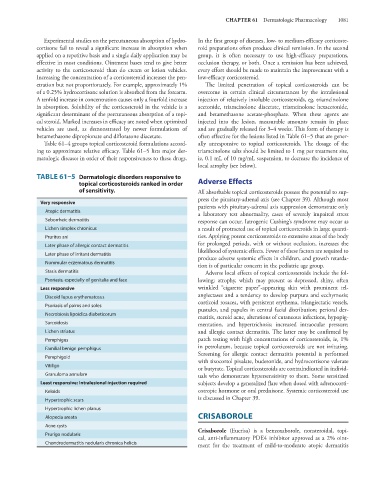Page 1095 - Basic _ Clinical Pharmacology ( PDFDrive )
P. 1095
CHAPTER 61 Dermatologic Pharmacology 1081
Experimental studies on the percutaneous absorption of hydro- In the first group of diseases, low- to medium-efficacy corticoste-
cortisone fail to reveal a significant increase in absorption when roid preparations often produce clinical remission. In the second
applied on a repetitive basis and a single daily application may be group, it is often necessary to use high-efficacy preparations,
effective in most conditions. Ointment bases tend to give better occlusion therapy, or both. Once a remission has been achieved,
activity to the corticosteroid than do cream or lotion vehicles. every effort should be made to maintain the improvement with a
Increasing the concentration of a corticosteroid increases the pen- low-efficacy corticosteroid.
etration but not proportionately. For example, approximately 1% The limited penetration of topical corticosteroids can be
of a 0.25% hydrocortisone solution is absorbed from the forearm. overcome in certain clinical circumstances by the intralesional
A tenfold increase in concentration causes only a fourfold increase injection of relatively insoluble corticosteroids, eg, triamcinolone
in absorption. Solubility of the corticosteroid in the vehicle is a acetonide, triamcinolone diacetate, triamcinolone hexacetonide,
significant determinant of the percutaneous absorption of a topi- and betamethasone acetate-phosphate. When these agents are
cal steroid. Marked increases in efficacy are noted when optimized injected into the lesion, measurable amounts remain in place
vehicles are used, as demonstrated by newer formulations of and are gradually released for 3–4 weeks. This form of therapy is
betamethasone dipropionate and diflorasone diacetate. often effective for the lesions listed in Table 61–5 that are gener-
Table 61–4 groups topical corticosteroid formulations accord- ally unresponsive to topical corticosteroids. The dosage of the
ing to approximate relative efficacy. Table 61–5 lists major der- triamcinolone salts should be limited to 1 mg per treatment site,
matologic diseases in order of their responsiveness to these drugs. ie, 0.1 mL of 10 mg/mL suspension, to decrease the incidence of
local atrophy (see below).
TABLE 61–5 Dermatologic disorders responsive to
topical corticosteroids ranked in order Adverse Effects
of sensitivity. All absorbable topical corticosteroids possess the potential to sup-
press the pituitary-adrenal axis (see Chapter 39). Although most
Very responsive
patients with pituitary-adrenal axis suppression demonstrate only
Atopic dermatitis
a laboratory test abnormality, cases of severely impaired stress
Seborrheic dermatitis response can occur. Iatrogenic Cushing’s syndrome may occur as
Lichen simplex chronicus a result of protracted use of topical corticosteroids in large quanti-
Pruritus ani ties. Applying potent corticosteroids to extensive areas of the body
Later phase of allergic contact dermatitis for prolonged periods, with or without occlusion, increases the
likelihood of systemic effects. Fewer of these factors are required to
Later phase of irritant dermatitis
produce adverse systemic effects in children, and growth retarda-
Nummular eczematous dermatitis
tion is of particular concern in the pediatric age group.
Stasis dermatitis Adverse local effects of topical corticosteroids include the fol-
Psoriasis, especially of genitalia and face lowing: atrophy, which may present as depressed, shiny, often
Less responsive wrinkled “cigarette paper”-appearing skin with prominent tel-
Discoid lupus erythematosus angiectases and a tendency to develop purpura and ecchymosis;
corticoid rosacea, with persistent erythema, telangiectatic vessels,
Psoriasis of palms and soles
pustules, and papules in central facial distribution; perioral der-
Necrobiosis lipoidica diabeticorum
matitis, steroid acne, alterations of cutaneous infections, hypopig-
Sarcoidosis mentation, and hypertrichosis; increased intraocular pressure;
Lichen striatus and allergic contact dermatitis. The latter may be confirmed by
Pemphigus patch testing with high concentrations of corticosteroids, ie, 1%
Familial benign pemphigus in petrolatum, because topical corticosteroids are not irritating.
Screening for allergic contact dermatitis potential is performed
Pemphigoid
with tixocortol pivalate, budesonide, and hydrocortisone valerate
Vitiligo
or butyrate. Topical corticosteroids are contraindicated in individ-
Granuloma annulare uals who demonstrate hypersensitivity to them. Some sensitized
Least responsive: Intralesional injection required subjects develop a generalized flare when dosed with adrenocorti-
Keloids cotropic hormone or oral prednisone. Systemic corticosteroid use
Hypertrophic scars is discussed in Chapter 39.
Hypertrophic lichen planus
Alopecia areata CRISABOROLE
Acne cysts
Crisaborole (Eucrisa) is a benzoxaborole, nonsteroidal, topi-
Prurigo nodularis
cal, anti-inflammatory PDE4 inhibitor approved as a 2% oint-
Chondrodermatitis nodularis chronica helicis ment for the treatment of mild-to-moderate atopic dermatitis

